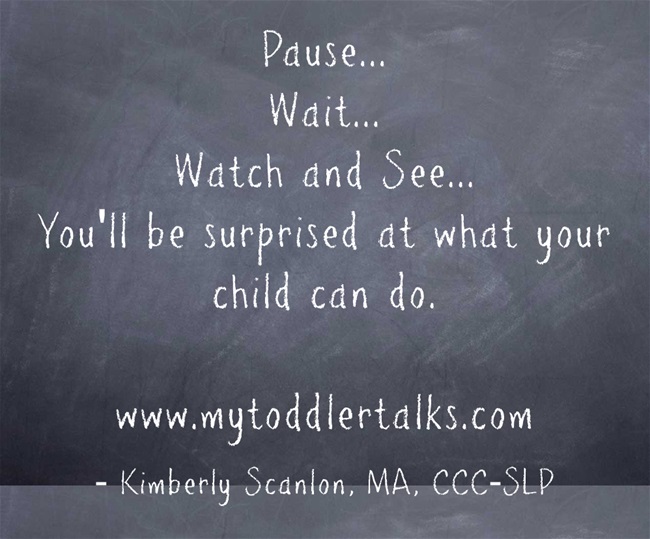Toddler Language Delay: How Pausing Improves Communication
Toddler Language Delay: How Pausing Improves Communication
In today’s busy and hurried world, it’s sometimes hard to slow down, take a breath and pause.
Yet, pausing and waiting when interacting with your child, in fact, greatly facilitates communication.
This sounds easy, right? Yet, it’s a skill that most of us need to practice. Luckily, with some guidance and training you'll be able to skillfully and effectively pause to increase the likelihood that your child will want to say something.
Photo Credit: fran-taylor
*Amazon affiliate links are included in this post.
For this post, I’m going to share a fictitious story inspired by my work experience.
There once was a boy, let’s call him Charles, who was 22 months old and not yet talking. He mostly communicated by grunting. (Folks, there are MANY children like Charles. Please do not feel you are all alone.) Mom and Dad were worried. About a month ago Charles started speech therapy. Since then he started to gesture and use some signs. Mom and dad were pretty happy with his progress, although they were still anxious because he was still developmentally behind. Fortunately, they were hopeful (which is something we should always be), because they saw improvement in their son. They were also happy because Charles’ speech language pathologist, let’s call her Kim, always taught them fabulous techniques (like self-talk and parallel-talk, giving choices, how to ask questions). Since Kim believed in a coaching model to help her parents learn and apply language development techniques at home, she often provided specific praise on how well a parent started to use a new technique. In this case, mom had started to give choices to Charles. Despite mom's improvement in giving choices to Charles, Kim noticed that mom was SO eager for him to respond that she DIDN'T give Charles enough time to process and respond to comments or questions. Mom would instantaneously repeat herself, re-ask the question, give in and hand over what he wants, or sometimes even make decisions for him.
Therefore, new targeted technique:
TO LEARN HOW TO PAUSE IN ANTICIPATION
What's pause in anticipation?
It’s when you wait approximately five seconds (count inwardly 3 to 5 Mississippis) to give your child a chance to respond to what you have asked or said. Show that you are waiting expectantly by raising your eyebrows, smiling, and opening your mouth.
What it’s not?
It’s not prompting for a certain word or phrase. There is no direct pressure for the child to respond a certain way. Any response is acceptable.
Why pause in anticipation?
Pausing in anticipation encourages spontaneous, natural communication. Since you are not requiring your child to say something in particular, you’re increasing the likelihood that he or she will initiate.
When to use pause in anticipation?
Pausing in anticipation is an excellent technique to use with children who are passive communicators; those who only respond and don’t initiate comments or questions. When you pause you’re providing the child time to process what you’re saying and doing, to collect his or her thoughts, and to freely respond.
In my book, My Toddler Talks, I share specific ways you can use pausing in anticipation while performing certain play routines.
But, if you’re in need of an example right now, try this:
Play with your child’s pretend food. I like Melissa and Doug Cutting Food Box Play Set:


While he or she is cutting up some food, use parallel talk –
“You’re cutting the apple”.
This way you’re showing your child that you're paying attention to what he or she is doing while also labeling the apple.
Next, say, “Hmmm…that apple looks yummy.”
Pause in anticipation.
DO NOT immediately ask for the apple! Count 3 to 5 Missiippis. See what the child does. Maybe Frankie wants to finish cutting the apple before handing you a piece.
If he doesn’t give you a piece, you can either make the same comment again, or reword what you had said:
“Oh, I’m sooo hungry (rub your belly –gestures are great!) that apple looks yummy. I want to eat it.”
Pause in anticipation.
The goal is that your child will want to either perform an action (give you the apple) or give you the apple AND also say something!!
"Here's the apple, Mommy!" or even "Apa ma".
Best of luck!!
If you are in need of some additional free and helpful resources, please subscribe to my newsletter - I share more information exclusively with my newsletter subscribers.
If you have enjoyed reading My Toddler Talks, please help spread the word about my book. Please tell your friends, write an honest review on Amazon, click the Facebook like button on landing page, or personally give me your feedback. I love hearing from my readers and value their input. You are the reason why I devote so much time to perfecting my craft :)

